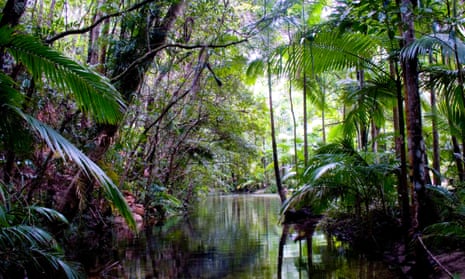Climate change is escalating as “the most significant threat” to Australia’s wet tropics world heritage area, with an update to parliament reporting the outlook for the bioregion is a cause of “great concern”.
The grim assessment of the critical north Queensland rainforest region is outlined in an annual snapshot of the protected area prepared by the Wet Tropics Management Authority, which urges greater national and international effort to address the causes of climate change.
The wet tropics world heritage area spans 450km of tropical north Queensland coastline between Cooktown and Townsville and comprises the world’s oldest living rainforests and the largest area of rainforest in Australia.
It also supports the highest level of biodiversity of any region in Australia, being home to 36% of Australia’s mammals, 29% of Australia’s frog species, 60% of Australia’s butterfly species and 50% of Australia’s bird species.
The agency’s two annual reports, one specifically on the state of the world heritage area, both warn that the conservation outlook for the region is deteriorating, with climate change seen as “likely to result in widespread and substantial ecological change”.
“Climate change is escalating as the most significant threat to the wet tropics long-term outlook, including changes to the distribution and density of endemic and specialised cool adapted rainforest species,” the report says.
“Changes to endemic and specialised cool adapted rainforest species distribution and density having already been recorded – and some somber predictions of modelled effects are already being realised.”
The agency reports that after receiving new evidence of the “accelerated decline of unique, endemic wet tropics animals”, such as the lemuroid ringtail possum which is at risk of imminent extinction, the board released a climate impact statement and a 10-point plan for climate adaptation.
“The board’s call is for urgent action and investment to improve resilience and protection to give the area the best chance of withstanding extreme events and climate impacts, pending a reduction in global emissions,” it said.
The snapshot also warns that “more extreme and unplanned bushfires” will occur in the future, posing a significant threat to the old-growth rainforest.
“Although not directly attributable to climate change, our rapidly warming climate, driven by human activities, is exacerbating every risk factor for more frequent and intense bushfires,” the report says.
Other threats reported by the authority include the damage being inflicted by invasive species, with feral pigs, yellow crazy ants, invasive weeds and pathogens such as myrtle rust all having an impact.
Funding cuts are also listed as a threat, with the authority reporting a “significant decline in research and monitoring of the property”.
“Despite previous historical investment in research in the area, research funding has significantly declined over recent years,” the report says.
Under the current National Environmental Science Program (2015-2021) commonwealth research funding investment into wet tropics rainforests was not a priority.
The final threat listed by the agency is the increased demand for infrastructure like roads, dams and energy supply, “caused by a growing urban population and tourist visitor numbers, distributing visitation across a wider area”.
The wet tropics area, which was declared protected in 1988, was also examined in 2017 by the International Union for the Conservation of Nature which carries out regular assessments of the world’s 241 natural world heritage sites.
The 2017 Outlook Report reported that the wet tropics region was under direct threat from “invasive plants, animals and diseases, and the high risk posed by the predicted impacts of climate change”.
The authority is concerned that the threat to the region’s ecology could also threaten the world heritage listing, which would have a knock-on effect to the Queensland economy.
“Climate change is one of the most significant threats to the area and is likely to result in widespread and substantial ecological change,” the report says.
“This change will impact the biodiversity values underpinning the world heritage listing of the area and has the potential to affect the region’s economy.”
A spokesman for environment minister Sussan Ley said the wet tropics was an “incredibly important area and one that receives significant funding.”
“In addition to its annual funding, the government has further invested $9m in crazy ant eradication and the formation of a Tourism Destination Development Plan to enhance opportunities for Indigenous cultural tourism enterprises and grow appropriate eco-tourism.
“We will continue to work with Queensland to protect this very important place.”
